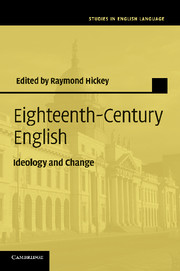Book contents
- Frontmatter
- Contents
- List of figures
- List of maps
- List of tables
- Notes on contributors
- Preface
- 1 Attitudes and concerns in eighteenth-century English
- 2 Prescriptivism and the suppression of variation
- 3 Women's grammars
- 4 Eighteenth-century women and their norms of correctness
- 5 Lowth as an icon of prescriptivism
- 6 Queeney Thrale and the teaching of English grammar
- 7 Coalitions, networks, and discourse communities in Augustan England: The Spectator and the early eighteenth-century essay
- 8 Contextualising eighteenth-century politeness: social distinction and metaphorical levelling
- 9 Expressive speech acts and politeness in eighteenth-century English
- 10 Variation and change in eighteenth-century English
- 11 Variation in sentential complements in eighteenth- and nineteenth-century English: a processing-based explanation
- 12 Nationality and standardisation in eighteenth-century Scotland
- 13 English in eighteenth-century Ireland
- 14 Changes and continuities in dialect grammar
- 15 ‘Be pleased to report expressly’: the development of a public style in Late Modern English business and official correspondence
- 16 Registering the language – dictionaries, diction and the art of elocution
- Timeline for the eighteenth century
- References
- Late modern English language studies
- Indexes
4 - Eighteenth-century women and their norms of correctness
Published online by Cambridge University Press: 06 December 2010
- Frontmatter
- Contents
- List of figures
- List of maps
- List of tables
- Notes on contributors
- Preface
- 1 Attitudes and concerns in eighteenth-century English
- 2 Prescriptivism and the suppression of variation
- 3 Women's grammars
- 4 Eighteenth-century women and their norms of correctness
- 5 Lowth as an icon of prescriptivism
- 6 Queeney Thrale and the teaching of English grammar
- 7 Coalitions, networks, and discourse communities in Augustan England: The Spectator and the early eighteenth-century essay
- 8 Contextualising eighteenth-century politeness: social distinction and metaphorical levelling
- 9 Expressive speech acts and politeness in eighteenth-century English
- 10 Variation and change in eighteenth-century English
- 11 Variation in sentential complements in eighteenth- and nineteenth-century English: a processing-based explanation
- 12 Nationality and standardisation in eighteenth-century Scotland
- 13 English in eighteenth-century Ireland
- 14 Changes and continuities in dialect grammar
- 15 ‘Be pleased to report expressly’: the development of a public style in Late Modern English business and official correspondence
- 16 Registering the language – dictionaries, diction and the art of elocution
- Timeline for the eighteenth century
- References
- Late modern English language studies
- Indexes
Summary
Introduction
When Horace Walpole (1717–97), the fourth Earl of Orford, discussed with a friend the alleged ‘female inaccuracy’ of constructions like between you and I, he was indulging in an incorrect allegation because men committed this grammatical ‘error’ just as often as women did (Tieken-Boon van Ostade 1994: 223). But the question also arises as to where women might have picked up the notion that prepositions are supposed to govern the accusative case. The education of the writer Lady Mary Wortley Montagu (1689–1762), for instance, consisted of learning to read, write, draw and do needlework (Halsband 1969: 36), while women of her class would have been taught music as well. Acquiring a thorough grounding in Latin grammar, which would have enabled her to apply the rule to produce the grammatically correct between you and me, was considered more suitable for boys than for girls (Cohen 2006). For a woman from the other end of the social scale, Elizabeth Clift (1757–1818), none of these subjects, let alone Latin, would have been within easy reach: she came from what we would now call a lower-working-class family from Bodmin in Cornwall, and spent most her life as a servant. But she had at least learned to read and write, though at a very elementary level only, as her surviving letters testify (Austin 1991).
- Type
- Chapter
- Information
- Eighteenth-Century EnglishIdeology and Change, pp. 59 - 72Publisher: Cambridge University PressPrint publication year: 2010
- 6
- Cited by



